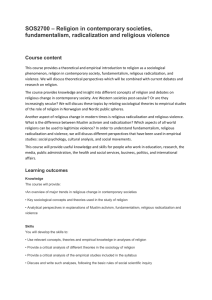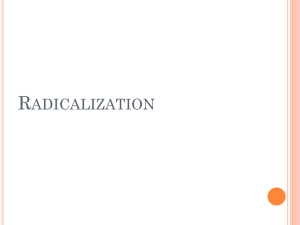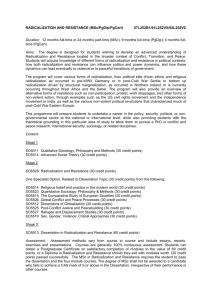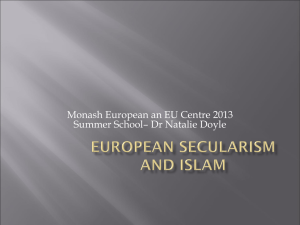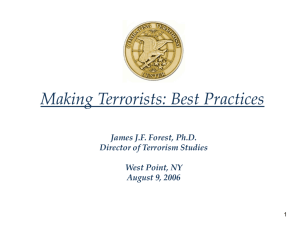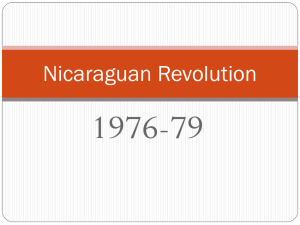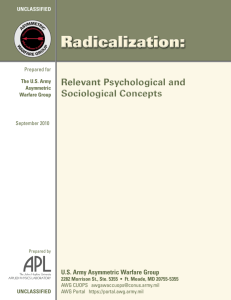Foreign Fighters - Canadian Network for Research on Terrorism
advertisement
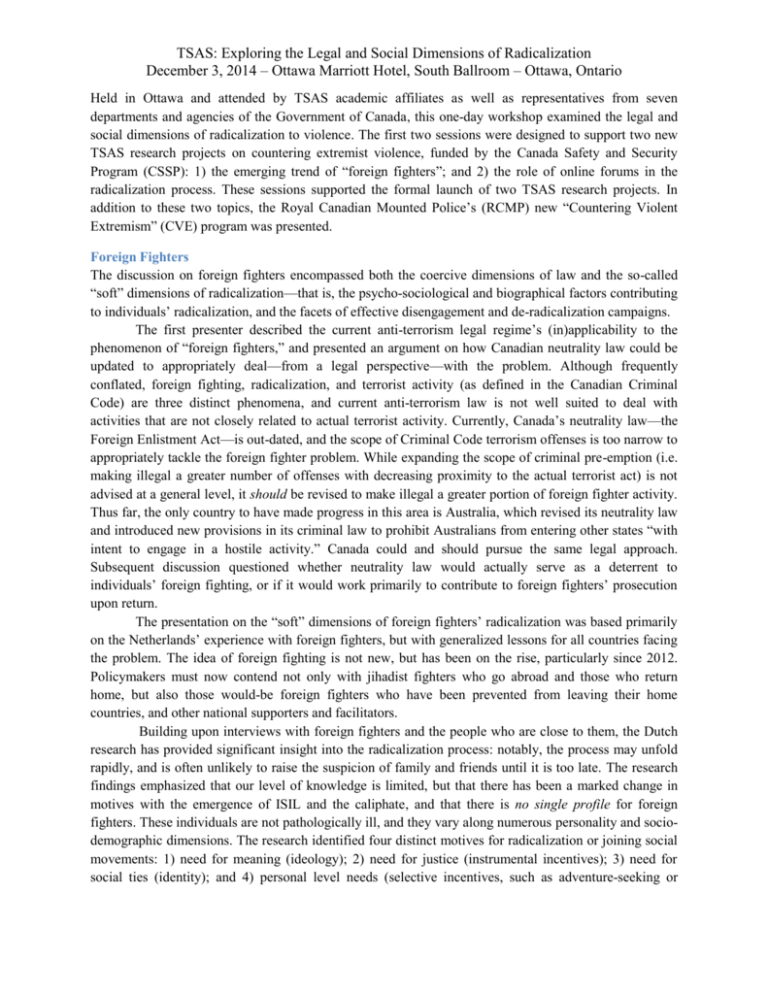
TSAS: Exploring the Legal and Social Dimensions of Radicalization December 3, 2014 – Ottawa Marriott Hotel, South Ballroom – Ottawa, Ontario Held in Ottawa and attended by TSAS academic affiliates as well as representatives from seven departments and agencies of the Government of Canada, this one-day workshop examined the legal and social dimensions of radicalization to violence. The first two sessions were designed to support two new TSAS research projects on countering extremist violence, funded by the Canada Safety and Security Program (CSSP): 1) the emerging trend of “foreign fighters”; and 2) the role of online forums in the radicalization process. These sessions supported the formal launch of two TSAS research projects. In addition to these two topics, the Royal Canadian Mounted Police’s (RCMP) new “Countering Violent Extremism” (CVE) program was presented. Foreign Fighters The discussion on foreign fighters encompassed both the coercive dimensions of law and the so-called “soft” dimensions of radicalization—that is, the psycho-sociological and biographical factors contributing to individuals’ radicalization, and the facets of effective disengagement and de-radicalization campaigns. The first presenter described the current anti-terrorism legal regime’s (in)applicability to the phenomenon of “foreign fighters,” and presented an argument on how Canadian neutrality law could be updated to appropriately deal—from a legal perspective—with the problem. Although frequently conflated, foreign fighting, radicalization, and terrorist activity (as defined in the Canadian Criminal Code) are three distinct phenomena, and current anti-terrorism law is not well suited to deal with activities that are not closely related to actual terrorist activity. Currently, Canada’s neutrality law—the Foreign Enlistment Act—is out-dated, and the scope of Criminal Code terrorism offenses is too narrow to appropriately tackle the foreign fighter problem. While expanding the scope of criminal pre-emption (i.e. making illegal a greater number of offenses with decreasing proximity to the actual terrorist act) is not advised at a general level, it should be revised to make illegal a greater portion of foreign fighter activity. Thus far, the only country to have made progress in this area is Australia, which revised its neutrality law and introduced new provisions in its criminal law to prohibit Australians from entering other states “with intent to engage in a hostile activity.” Canada could and should pursue the same legal approach. Subsequent discussion questioned whether neutrality law would actually serve as a deterrent to individuals’ foreign fighting, or if it would work primarily to contribute to foreign fighters’ prosecution upon return. The presentation on the “soft” dimensions of foreign fighters’ radicalization was based primarily on the Netherlands’ experience with foreign fighters, but with generalized lessons for all countries facing the problem. The idea of foreign fighting is not new, but has been on the rise, particularly since 2012. Policymakers must now contend not only with jihadist fighters who go abroad and those who return home, but also those would-be foreign fighters who have been prevented from leaving their home countries, and other national supporters and facilitators. Building upon interviews with foreign fighters and the people who are close to them, the Dutch research has provided significant insight into the radicalization process: notably, the process may unfold rapidly, and is often unlikely to raise the suspicion of family and friends until it is too late. The research findings emphasized that our level of knowledge is limited, but that there has been a marked change in motives with the emergence of ISIL and the caliphate, and that there is no single profile for foreign fighters. These individuals are not pathologically ill, and they vary along numerous personality and sociodemographic dimensions. The research identified four distinct motives for radicalization or joining social movements: 1) need for meaning (ideology); 2) need for justice (instrumental incentives); 3) need for social ties (identity); and 4) personal level needs (selective incentives, such as adventure-seeking or TSAS: Exploring the Legal and Social Dimensions of Radicalization December 3, 2014 – Ottawa Marriott Hotel, South Ballroom – Ottawa, Ontario limited career options). Disengagement efforts must take the particular motive for radicalization into account; for instance, those who join in a search for meaning or justice will face normative barriers to disengagement, while those searching for social ties will face affective barriers, and those motivated by personal or selective incentives will face continuance barriers. There is insufficient knowledge, at this stage, regarding which policy measures—both “hard” repressive measures (e.g. travel bans, arrests, and trials) and “soft” preventative measures (e.g. working with communities and families)—are effective, and so the European Union has met political resistance in implementing policies to deal with the foreign fighter issue. Ethical Research in Terrorism This segment elaborated the research ethics hurdles faced by the CSSP project “Empirical Assessment of the Lives of Canadian Terrorists,” which will be focused on current and would-be foreign fighters’ personal experiences and perceptions. Before data collection can begin, the host university’s research ethics board must approve the project, adhering to the Tri-Council Policy Statement: Ethnical Conduct for Research Involving Humans. Despite beginning extensive ethics consultation in July, revisions to the ethics proposal (as of December 3) are still ongoing, primarily due to a lack of understanding of Terrorism Studies and its methods of inquiry among the broader research community; suspicion of government partnerships; and concerns related to participants’ interests and a worry that they might wish to harm researchers. Subsequent rounds of revisions have sought to satisfy the board’s concerns about the potential for the research to contribute to racial profiling,; risks to interviewees, the researchers, and even university staff, the confidentiality of interviewees and data, legal concerns and obligations to disclose information, and whether participants and community social workers (serving as mediators to identify participants) would be compensated for their participation. Online Forums This portion of the workshop addressed the role of online forums in the radicalization process, and included both findings from a completed research project and a discussion of the methodological processes of ongoing research. The completed research project examined (non-password-protected) Internet activity of seven US-based extremists, using content analysis, to gain insight into the radicalization process. While there were clear differences in the individuals’ posting patterns (i.e. frequency, level of aggression, topics of interest, level of sophistication, etc.), there were also commonalities. Most significantly, all of the individuals were extremely interested in religion, particularly at the beginning of their “online lives” when they participated in forums as avid seekers of religious knowledge. Over time, the individuals demonstrated a progressive closure to new information. In most cases, these individuals also exhibited a particularly strong disdain for moderate Islamists. The methodological discussion surrounded the early stages of a new CSSP project, “The Emergence of Violent Extremism in Online Forum Networks,” which seeks to examine the emergence of violent extremism in the life-course trajectories of online forum participants (i.e. a micro-level approach, examining individuals’ personal details and turning points in online behaviours) as well as the effect of major developments regarding ISIS in Syria and Iraq on the social structure of ISIS-related forum discussions (i.e. network dynamics and the generation of violent narratives). The research has begun with the manual coding of online posts of a single forum user, according to the degree of violence and their relationship to life events (e.g. entering college, marriage, fatherhood, and external events). Since manual coding of these events is unfeasible on a large scale, the researchers explored Sentiment Analysis, using “SentiStrength” software. The automated SentiStrength violence scores perfectly correlated with the overt TSAS: Exploring the Legal and Social Dimensions of Radicalization December 3, 2014 – Ottawa Marriott Hotel, South Ballroom – Ottawa, Ontario and suggested violence scores of the manual coding, thus validating its accuracy. The project also examined the influence of external events on overall forum activity, which explored the role of “opinion leaders” or “idea entrepreneurs” in spurring debate on topics—even after the initial post-event burst dies down. Operationally, the knowledge gleaned from the study of online forums is significant, particularly with respect to informing de-radicalization efforts. For instance, the logic of de-radicalization has previously sought to exploit moderate voices in the Muslim community. However, if radicalized individuals see these voices as illegitimate or unworthy, this logic is unlikely to yield results. In a similar vein, identifying the characteristics of opinion leaders and their discourse will provide insight into how— and via whom—to stimulate positive responses in online forums. By identifying vulnerable points in the radicalization process (i.e. at the stage of belief construction, rather than consolidation), de-radicalization efforts can better target when to intervene and who will be open to intervention. The next step for research using data gleaned from online forums is to examine the interaction between online and real world behaviours, and for a comparison between the views presented in open and password-protected forums. The RCMP Countering Violent Extremism (CVE) Program The day closed with a presentation of the RCMP’s new CVE program, which seeks to engage communities on the topic of radicalization to violence in view of diminishing the home-grown terrorist threat via prevention in the pre-criminal space. The process begins with awareness, education, tools and multi-agency involvement. It is only in those cases where these processes fail that criminal space investigation—involving disruption, arrest, charges, and prosecution—become necessary. Some CVE components have already been tested, with thirty trained RCMP officers across the country; the RCMP is currently in the process of building a team to expand the program in a “train-the-trainer” format, to engage municipal police partners and existing community hubs (e.g. health professionals, education boards, social services, etc.). Beyond the CVE, Public Safety Canada has been actively involved in helping communities develop their own intervention programming, providing them with the tools and knowledge required to intervene effectively in individuals’ radicalization to violence pathway. One technique that has seen positive results is story-telling: the department has created first-person narratives—based on elements of various national security cases—to describe personal experiences of radicalization to violence and/or of foreign fighters. The stories serve to facilitate discussion on what community members can do to address some of the issues at play, thereby opening the door to intervention. The technique has yielded significant interest from communities, and is preferable to offering an impersonal “checklist” of radicalization indicators. At a broad level, the events of October 20th and 22nd were a tragic reminder that Canada’s list of home-grown terrorists is increasing, and communities have responded positively to preventive efforts. Still, to generate more effective prevention and de-radicalization programming, we require more data about the processes occurring in vulnerable communities. This research effort is vital to both the research and policy communities, in Canada and abroad.
